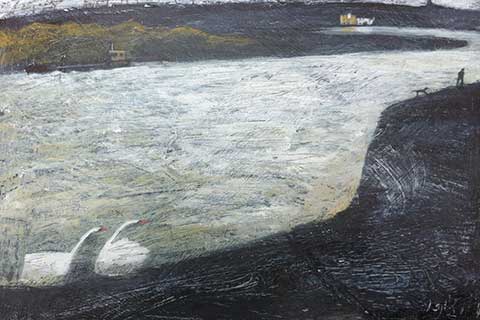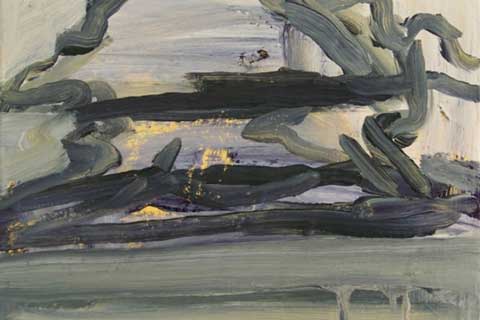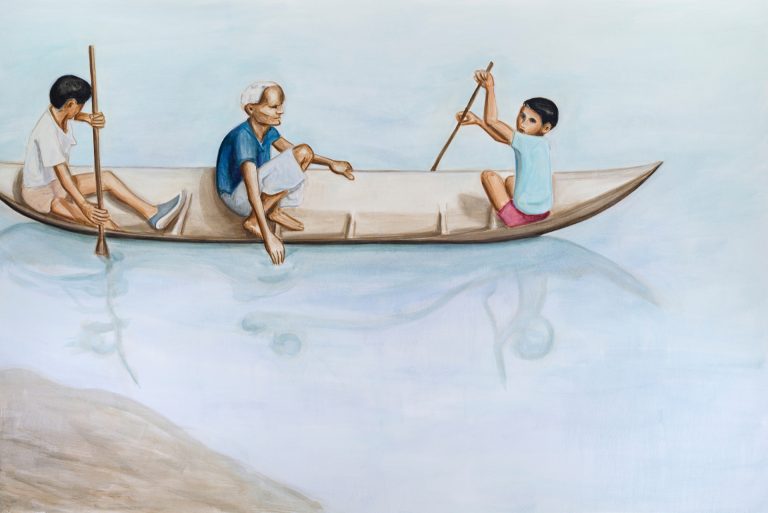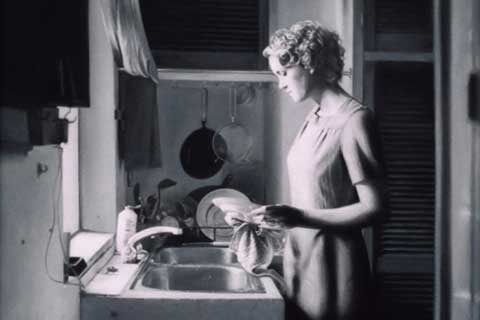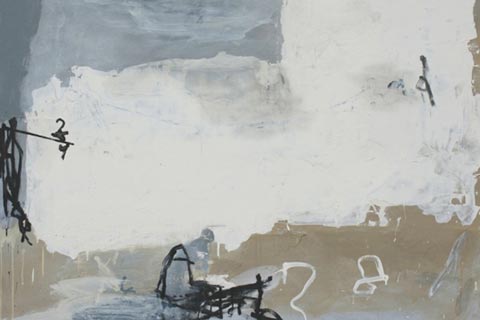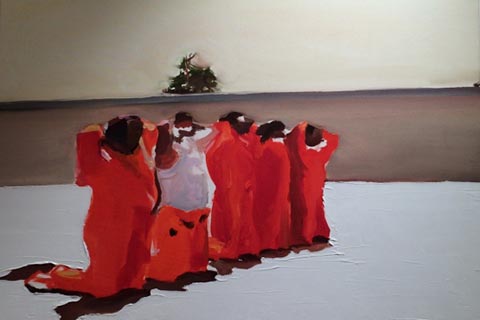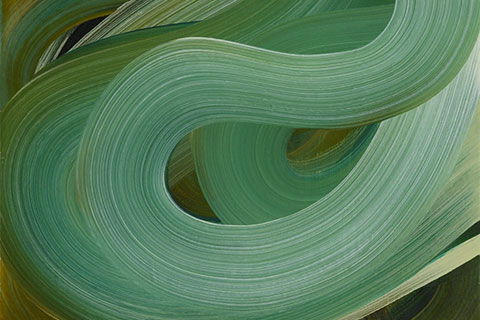Barbara Peirson in conversation with Simon Carter

Simon Carter: The first thing I would like to ask you is whether you have seen the Alfred Wallis show at the Art Exchange at Essex University?
Barbara Peirson: Yes I have.
SC: Do you think there are things in Alfred Wallis that inform what you do?
BP: Absolutely, there’s no doubt about that.
SC: I’ve always thought that your work has a strong relation to Alfred Wallis but not in the sense that his work has a naive simplicity to it, I think yours relates to his in a different way. What do you think is the relationship?
BP: Well the cardboard is a relationship without a doubt, but I can’t remember when I first became aware of his work. My brother-in-law and sister-in-law were living in a house in Cambridge that contained some Alfred Wallis’ and I think maybe that was the first time I saw them and kept seeing them and kept being drawn back to them. I think what happened was that when I became allergic to painting in oil I had to learn to paint in acrylic, and I started to teach myself by painting on bits of cardboard. Guy Taplin came round and saw them. I said, “That’s not a proper painting because I’ve only painted it on a piece of cardboard”, and he said, “I’ll buy it”!
SC: He’s a big fan of Alfred Wallis isn’t he? He told me to go and see it.
BP: Yes he’s a big fan, and then I realised that I had been going round to his house and seeing Alfred Wallis’ on the wall. I suppose bit by bit it has infused into what I do.
SC: Is there something about the straightforwardness to what Wallis does? It is uncomplicated by art theory in a sense isn’t it?
BP: Yes that’s true. I would love to be able to be that straightforward.
Simon: Do you think you have to be ‘naive’ to be that straightforward? Wallis wasn’t connected to the art world in any way until Ben Nicholson found him.
BP: I don’t know the answer to that.
SC: The poet Derek Mahon wrote: ‘We know too much to be anything anymore’. I suppose what he is saying is that if you know too much you can’t be direct.
BP: I think that is right but there is also that fear; I feel that Wallis was fearless. I think that because I am educated and did Art Foundation… I think Art Foundation actually helped to take some of my fear away but with me there was a fear of getting it wrong and I think what I see in his work is a fearlessness. There is no worry about getting it wrong.
SC: There is a fearlessness in Picasso as well but it comes out as something different.
BP: It does and it looks like he has that tremendous confidence but I’ve noticed as well that it is unlearning; it’s about unlearning everything.
SC: Yes, it’s not like acquiring a skill, it’s way beyond that isn’t it; you’ve almost got to un-acquire the skill that you have got.
BP: Yes, so that you can forget it and leave it behind.
SC: So are there other influences on your work that you think are more significant than Wallis?
BP: I think that the work that I get drawn back to and back to is David Hockney and Picasso and you! I think also Mary Newcomb and Mary Fedden and Lowry.
SC: Explain a little bit about your background; you did not go directly to art school…
BP: No, I went drama school. I had a choice when I was at school to go to drama school or art school and when I got into drama school I went to drama school because I was so shocked to have got in!
SC: So it wasn’t a conscious decision to follow that path, it just happened that way.
BP: Yes, it was accidental and it always felt like a thread in my life that was waiting for me to pick up later on because I really wanted to go to art school. I was at a school where they told me that I would never get in and it wouldn’t give me a career. I thought that if I could get a career working as a restorer in a museum… but they said I would be better off studying chemistry which I did! I studied chemistry, physics and maths for a year and then realised I hated it and so then I took art and English. A teacher told me that I could go to drama school if I wanted to so I auditioned and got in. I got swept away with that and I loved it and have had the most wonderful career. I’ve done a lot of directing as well which in many ways is like painting moving pictures on stage.
SC: I was going to ask you that, what is there in acting and directing that translates into painting?
BP: I think what’s always been interesting working in the theatre is that it is very much to do with ideas and the word. The kind of theatre that I have been most involved with is to do with ideas that are quite near the surface and what I have always been drawn to is work that is more mysterious, with things that can’t be explained. I suppose I am always searching for that thing that can’t be put into words and that is what has led me towards painting now.
SC: So do you feel you came back to painting or was it there all the time?
BP: Oh it was there all the time and I’ve always kept sketch books but I had never painted in oil until I did Art Foundation, when Emma Cameron was my teacher. I was waiting for this big day to paint in oils and she said, ‘OK, there you go, there are the paints, there are the brushes’. I thought, ‘Where is all this teaching?’ Then of course I realised that it is all about experimentation and play and discovery.
SC: There is still a feeling that unless you are painting in oils you are not really painting isn’t there?
BP: Yes there is.
SC: I find that laughable really.
BP: I can understand it because there is something about the texture of those paints that is …
SC: There is a history built into them as well isn’t there?
BP: Yes there is and when I went to Rembrandt’s house recently I was there with this wonderful artist in his studio. That was so exciting and watching her mix the paints and listening to her explain about the paints I realised absolutely that they carry that history. She explained why the reds are still present in Rembrandt’s paintings and they are not in Van Gogh’s because of the quality of the ingredients.
SC: When you look at the history of oil painting as we understand it, it is probably five hundred years old, and the history of painting is thirty or forty thousand years old, so it is a little blip in a way isn’t it.
BP: That’s true.
SC: One thing I like about acrylics is that their history is so short, they haven’t go that weight of history when you paint in them, but there is a sense you get from some people that acrylics is just pretending to paint rather than actually painting!
BP: That’s right, it’s like I suppose the difference to some people between a silk dress and one made out of synthetic nylon. It’s not really because when you use them… and that was the great discovery, practising with them and forcing myself… because at first I really didn’t know how to make them work. It’s just so great because I just find that finding the painting in the painting is to do with, it’s so arbitrary really, because it just is to do with how the paint is drying, and forever learning about each colour and how you are dependent on it in some way, you have to go with it.
SC: Yes, and there’s like a liberation in using acrylic in that they are technically sound, you can do lots of things to them and it won’t crack and it won’t dry differently over something else. It’s all very sound and I just find that a liberation, I don’t have to think about craft things, you can really concentrate on, like you say, finding the painting in the paint.
BP: Yes.
SC: What is the source material for your paintings then, where do they come from?
BP: I come from the North East and when I first moved to Wivenhoe everyone said, ‘It’s so beautiful’. I went walking along the estuary on a grey day and it was just grey above and grey below and it was completely flat and I thought, ‘This is horrible!’ It has been this long love affair really where I’ve completely fallen in love with it and it is to do with understanding that that’s the subtle beauty in it all. In a way it is like meditation, you have to get into it, you have to focus in on it and you learn that by visiting it regularly, and the glory of it is that it is always different. With the estuary going in and out, and the sky, and the water reflecting the sky, and the tide can be at any point at any point in the day, and at any point in the year and season, and it’s always different.
SC: So is that the subject do you think, the fact that there is this thing out there that’s constantly living its own life and you are sort of dipping in and out of it; is that the subject? In a sense you could walk the other way and go up onto the fields or into the woods.
BP: I suppose so, and I do try to do that and I do love the way the light comes in through the woods but actually it’s the water and the sky really…
SC: So what part does direct observation play? Do you make notes and drawings out?
BP: I do exactly that. I take notes and a sketch book and I always feel I am not very good at sketching or my sketches aren’t very good. I like the drawings but I’m not very good at sketching I feel. I write down the colours that I see and try and… it’s so hard to remember them. I have to keep repeating it over and over and over to myself like, ‘Today it was like mercury and gold’, in order to try and embed the memory of the colour somehow.
SC: I find if I go out and use colour outside directly there’s just too many things that I see. If I’m drawing I can remember a couple of relationships in the colours or I remember a particularly vivid green or something like that. I can bring that back and have a little look at that and then go out the next day and then I think, ‘Right I’ve learnt what that green is doing a little bit now’ and I go and have another look at it. But I find if I start using colour too directly outside I can see all sorts of things.
BP: That’s really reassuring!
SC: Why do you paint on fragments of card?
BP: I have found that the card is really liberating because I don’t feel precious about it. With a canvas it can freeze me up whereas the card doesn’t, it’s because it’s disposable. But I also love the edges of it and the shapes in it and the texture and, for me, most of all I love how the paint works on it. There’s something perfect for me about the way the card absorbs the paint, or not!
SC: And they exist like little fragments of something real as well don’t they, because they have little edges and shapes, they really do exist in the same world as all the other objects that are gathered around you.
BP: Yes, I suppose that’s it.
SC: I know what you mean about canvas. I think that again it is that weight of history that a canvas has. It’s a thing in your mind and it’s really difficult to get it out of your mind because you don’t consciously think it.
BP: I didn’t feel that so much when I was painting in oils on canvas because I could get the texture of the canvas and the oil paint and I was interested in that, seeing the canvas through the oil paint, but I can’t do that very well with acrylic…
SC: You are involved in theatre, in directing and acting and painting; is there something singular about painting that makes it stand out from other means of expression, or do you think it is just one way of saying something amongst many?
BP: It’s interesting your use of the word singular because it is very individual and personal and it’s just you, whereas with the theatre it’s always a collaborative process so you are a part of a whole thing. That’s the difference. It’s also the difficulty about working in theatre because you need the other people around you to make it happen. It’s really frustrating to not be able to have a daily practise; usually you can’t do it unless you’ve got a job so there isn’t a daily practise. I think that what’s so wonderful about painting is that you can do it wherever you want to, whenever you want to, whenever you can, on your own and you can keep it going and the work endures. With theatre it is gone.
SC: So it’s almost that it happens under the radar, it’s a secret activity because it’s just you and the materials.
BP: And it does feel very secret, and because I go out really early in the morning like you do, when there is nobody around , it feels like it’s a secret time of day and it’s a secret activity.
SC: Yes I get exactly what you are saying. When my youngest son went for an interview for architecture school one of the tutors said to him, ‘Are you sure you don’t want to go to art school because when you are painting you are in charge, when you are in architecture you only think you are in charge.’ It is that thing about having a team of people, you can’t be an architect and not have a team of people. I guess you can’t be a director without a team of people, but you can really be in charge of painting and it’s just you and the materials.
BP: Yes you can. Funnily enough I relate painting much more to acting than I do to directing, even though directing is like painting with people and characters and light and objects, but I’m more connected to the process of acting when I am painting than I am…
SC: So acting is like a sequence of moments that add up to something, it’s a performance isn’t it, a kind of time bound performance. Is painting like that to you?
BP: Painting isn’t it a performance. Acting is really a process so it takes you a while, it takes you several weeks to get to the performance and it’s the process of getting there that is similar. It’s about using your technique and building on your technique and going with your intuition and then discovering the things that you didn’t know were there and getting through the known to the unknown I suppose.
SC: So when you come to performance in acting you are performing the same piece several times. Is it different each time you do it?
BP: It is yes.
SC: Is that the same when you are painting because you are really taking quite a small subject area…
BP: Yes and its different every time.
SC: …and you are not repeating yourself are you?
BP: That’s true, I hadn’t thought of that.
SC: So it has got a similarity to that.
BP: There is a similarity and when you do a performance every night you know that what you are aiming for is to be in the moment, so that there is no sense of you having done it before, so that in this moment there is that life that comes from being in the moment, being truthful in the moment, that is what you are striving for. You don’t always get it; you can go through the motions.
SC: That sounds like a good description of painting.
BP: That is what’s the same, it’s that thing of trying to get to that point where you are in the moment and it does it itself somehow; it’s a truth in the moment. When you try and recreate something, which often I do in painting, it’s without life often.
SC: There’s a difference between it actually being an act with meaning and just going through the motions of an act.
BP: Yes, and maybe that is what I see in Van Gogh’s work really. Is it that? That when you walk into a room you just immediately… I see it with your work, I don’t know why your paintings take my breath away, there is no logic to it, except it must be that you have caught that moment of truth that I understand and is beyond words really.
SC: Thank you.
February 2013



